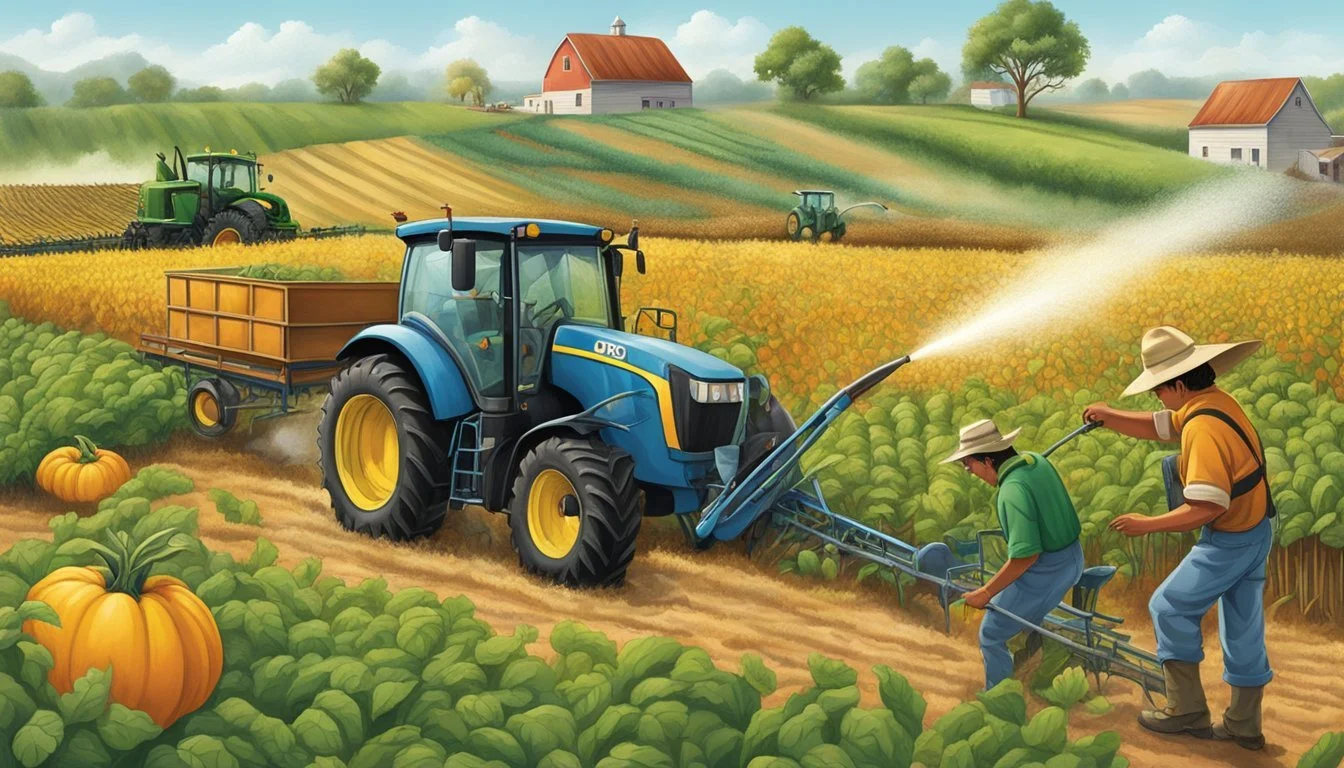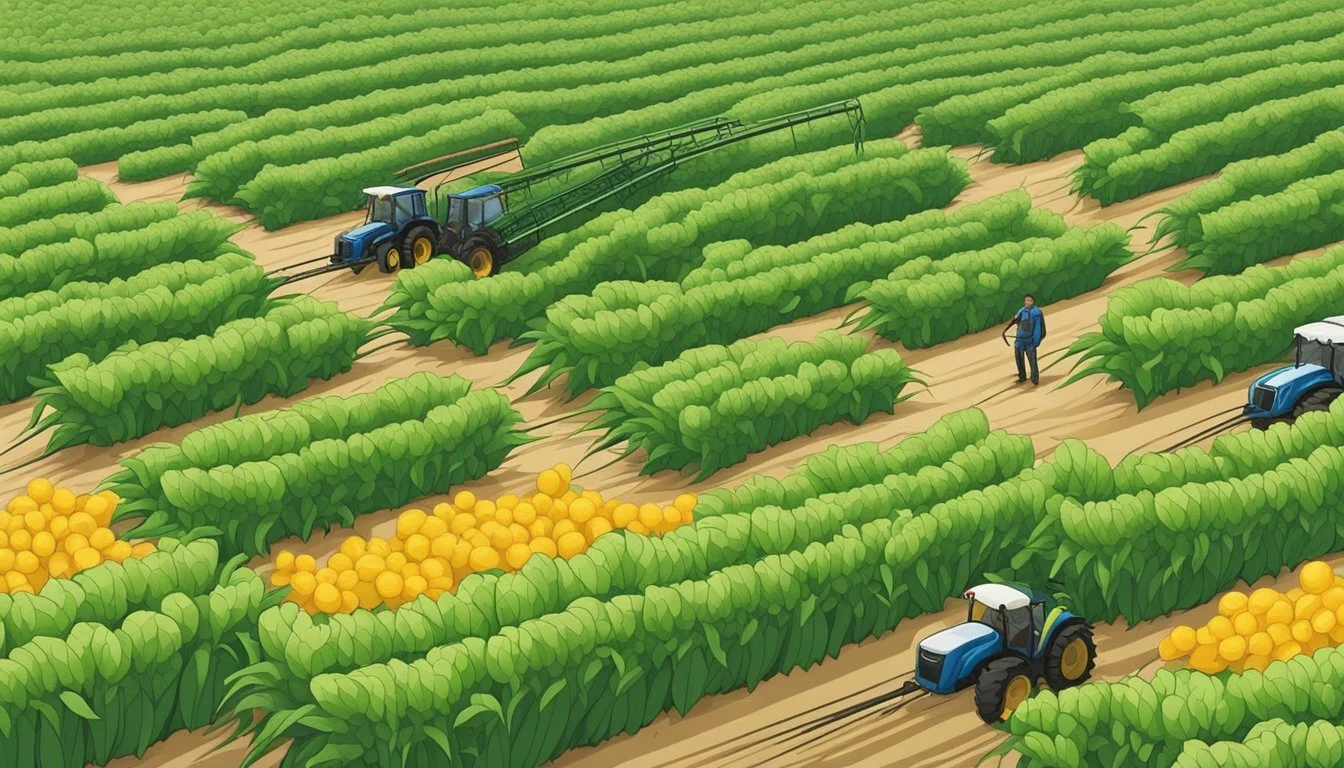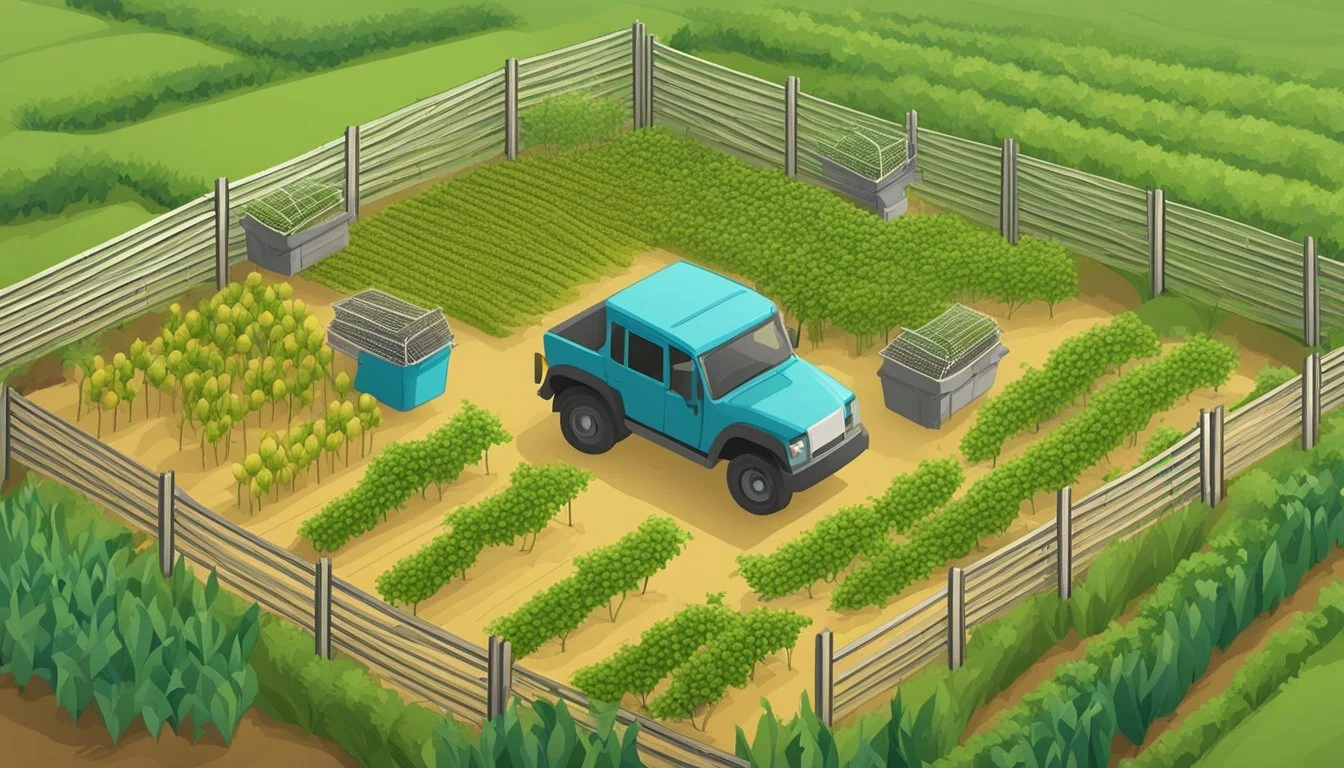Protecting Crops from Horntails
Integrated Pest Management Strategies
Horntails, also known as wood wasps, pose a significant threat to forestry and can impact agricultural crops indirectly through their choice of nesting in weakened trees. These insects lay their eggs in trees, and the emerging larvae can cause further damage as they bore into wood, potentially weakening the trees that might be an integral part of an agricultural ecosystem. Farmers are increasingly aware of the need to protect their crops from various pests, and although horntails do not directly attack crops, their presence in nearby forestry can be indicative of greater environmental disturbances that may indirectly affect crop health.
Effective crop protection strategies must take into account the lifecycle and behaviors of pests like horntails. Knowledge of their development in trees that have been compromised by external factors such as fire, wind, disease, or mechanical damage is crucial for early detection and prevention. Agricultural professionals seek methods to ensure that their crops remain healthy and that any potential threats from forest-dwelling insects like horntails are mitigated. This includes regular monitoring of tree health in and around crop areas and implementing control measures when necessary to prevent the horntails from causing significant damage to the local forestry which, in turn, supports crop vitality.
Biology of Horntails
Horntails are a unique group of wood-boring insects with specific physical traits and reproductive habits, crucial for understanding their impact on forestry and agriculture.
Physical Characteristics
Horntails, members of the insect order Hymenoptera, are characterized by their robust, cylindrical bodies. These arthropods typically exhibit colors ranging from black, brown, and sometimes with yellow or rust markings. Adult horntails can be identified by a spine-like projection (horntail) at the tip of their abdomen.
Life Cycle and Reproduction
The life cycle of horntails goes through several stages. Females use their ovipositor to lay eggs inside wood. Once the eggs hatch, the wood becomes home to the larvae, which feed on the wood and create tunnels filled with wood shavings as they grow. The larvae mature inside the wood before eventually emerging as adults to continue the reproductive cycle.
Diet and Habits
Horntails have a diet that is intimately connected with wood. They feed on both softwood and hardwood, particularly when in the larval stage, which facilitates their development and growth. Their habits, including ovipositing in various forest trees, can impact the health and quality of timber, making understanding their biology paramount for effective forest management strategies.
Horntails as Crop Pests
Horntails pose a significant threat to a variety of woody plants and crops due to their wood-boring larvae which can lead to structural damage and potential crop loss.
Damage to Plants and Crops
Horntails, or wood wasps, exhibit a life cycle where the larvae burrow into plant tissue, causing physical damage to trees and woody crops. The tunneling activity not only weakens the plant structure but also creates entry points for fungal infections, further exacerbating the damage. Major concerns arise when horntails attack trees used for timber or those in close proximity to agricultural areas. While they may not directly target food crops, the impact on plant pests can extend to nearby food-producing areas.
Host Plants and Crop Susceptibility
The host plants most susceptible to horntail infestations include, but are not limited to, pine, oak, and other hardwoods. While horntails typically prefer weakened or dying trees, their presence can threaten forestry operations and, by extension, impact the availability of wood for agricultural uses such as stakes and trellises for vegetables, cotton, and other food crops. Crop susceptibility to indirect damage must be considered when assessing and managing horntail populations.
Monitoring Horntail Population
To effectively protect crops from horntails, regular monitoring of their population size and infestation levels is critical. This can be done through visual inspections of susceptible host plants and the use of traps. Understanding the lifecycle of horntails assists farmers and land managers in predicting the timing of adult emergence and egg-laying, enabling preemptive measures to mitigate impact before horntails reach a population level capable of causing significant damage.
Prevention and Control Strategies
Effective management of crops against horntails involves an integrated approach that combines cultural, biological, and chemical strategies. Each method focuses on minimizing damage and preserving the crop's health while considering environmental impact.
Cultural Control Practices
Cultural practices are fundamental in preventing horntail infestations. These include prompt salvage of damaged trees in forestry operations. The quick use of felled timber can significantly reduce the risk of horntail colonization and subsequent damage. Moreover, maintaining weed management around crop areas can help reduce potential horntail habitats.
Biological Control Methods
Biological control leverages natural enemies like predators, nematodes, and fungi to target horntails. For instance, introducing specific biological agents that prey on or parasitize horntail larvae can establish a biological line of defense. This method aligns with pest management objectives to sustainably control plant diseases and pests without harming beneficial species.
Chemical Control Measures
When necessary, chemical control measures such as insecticides and synthetic pesticides may be employed. This should always comply with EPA guidelines to mitigate environmental impact. It’s essential to select chemical products carefully to avoid the development of resistance in horntails. Kiln drying of lumber, as a non-pesticidal approach, is recognized to effectively kill larvae within wood products, further preventing the emergence of horntails in finished goods.
Integrated Pest Management (IPM)
Integrated Pest Management (IPM) stands as a sustainable approach to managing pests by combining biological, cultural, physical, and chemical tools in a way that minimizes economic, health, and environmental risks.
IPM Principles
IPM principles focus on long-term prevention of pests or their damage through a combination of techniques such as biological control, habitat manipulation, and modification of cultural practices. By understanding the life cycle of pests and their interaction with the environment, farmers and scientists can implement strategies that are precise and sustainable. These principles support enhanced agricultural practices and promote competition against pests for the benefit of crop yields.
IPM Implementation
To implement IPM, farmers should consider weather conditions, crop characteristics, and pest life cycles. Precision in the application of IPM strategies, such as cultural control methods like crop rotation and intercropping, or physical controls including traps and barriers, is essential. Chemical crop protection is used as a last resort and applied in a manner that is cost-effective and the least disruptive to ecosystems. Technologies like sterilization of pests or use of resistant varieties are also integral to IPM.
IPM Benefits
IPM offers multiple benefits; it is a sustainable and environmentally sensitive approach to pest management that helps maintain biodiversity and reduce reliance on chemical treatments. By employing IPM, farmers can improve the health and sustainability of their land and local ecosystems, resulting in more cost-effective farming over time. Enhanced crop yields and reduced costs are also significant advantages of a well-implemented IPM program.
Case Studies and Research
Research in crop protection forms the cornerstone of ensuring agricultural production remains unaffected by pests such as horntails. Findings from One Health suggest that employing an interdisciplinary approach enhances the efficacy of managing outbreaks of pathogens and pests which threaten crops.
Monitoring and Detection
Agricultural experts emphasize the significance of early detection and monitoring systems for pests in crop protection strategies. For instance, studies published in Frontiers in Plant Science reference advancements in monitoring harmful insects, which are key to protecting both forage and grain.
Integrated Pest Management (IPM)
IPM strategies diversify the approaches to pest control, often limiting the need for chemical interventions such as DDT. Research encourages crop protection products that align with sustainable practices, safeguarding stored products without compromising environmental health.
Agricultural Practices and Biodiversity
A study highlighted by Phys.org reveals how the purposeful planting of flowers on farms can attract predatory insects that naturally manage horntail populations, thus protecting apples and potentially other crops.
One Health and Food Security
The one unified Health framework integrates plant, human, and animal health, showcasing how the health of livestock and crops are interconnected. This framework provides case studies exemplifying how the management of plant health promotes overall food safety and security, a critical component documented in the research on One Health's influence.
These studies reinforce that strategic, informed, and multi-disciplinary approaches are vital for the protection of crops from horntails and other pests, subsequently securing agricultural yields and contributing to food security.
Impact and Management of Pesticide Resistance
The emergence of pesticide resistance in various pests poses a serious threat to crop protection strategies. When pest populations develop resistance, they become less sensitive to pesticides, leading to reduced effectiveness of these chemicals. This issue not only undermines the ability to manage pests like horntails effectively but also can drastically increase the cost of agricultural production due to more frequent and higher volume applications of pesticides.
Management strategies to counteract resistance are multifaceted. They should be grounded in a thorough understanding of pest biology and the mechanisms of resistance development. The Environmental Protection Agency (EPA) plays a crucial role in this regard, regulating the use of pesticides and advocating for Integrated Pest Management (IPM) practices. These practices include:
Rotating pesticide classes: to prevent pests from becoming resistant to a particular mode of action.
Using the right dosage: to ensure effective control while minimizing the chance for resistance to build up.
Monitoring pest populations for early detection of resistance.
To further curb the spread of resistance, agricultural stakeholders must:
Employ non-chemical control methods, such as biological controls.
Cultivate crops with inherent resistance to pests.
Apply pesticides judiciously and only as needed.
Through these combined efforts, the impact of pesticide resistance can be reduced, securing the effectiveness of pesticides for future use and supporting sustainable agriculture practices.
Environmental and Health Considerations
When protecting crops from horntails, a type of wood-boring insect that can cause significant damage to trees, it's essential to consider both the environmental impact and health implications of pest control methods.
Integrated Pest Management (IPM) strategies are favored as they minimize harm to the environment and human health. IPM employs a combination of biological, cultural, and chemical methods that are selective and sustainable:
Biological Controls: This involves the use of natural predators or pathogens to manage horntail populations. These methods do not contribute to air pollution and help preserve beneficial insects within the ecosystem.
Cultural Practices: Farmers can adopt crop rotation and plant resistant varieties to reduce the prevalence of horntails without affecting soil health or air quality.
Chemical Treatments: When necessary, the use of insecticides should be cautiously applied to minimize any adverse effects on the environment and non-target species.
Table 1: Impact of Pest Control on Environment and Health
Biological Controls: Low risk of air pollution, Reduced chemical exposure
Cultural Practices: Preservation of soil, Minimization of allergens
Chemical Treatments: Potential for air pollution, Risk of chemical exposure
Given the potential for plant disease transmission by horntails, the selection of least-toxic options is critical. The use of systemic insecticides should be scrutinized, as they can contaminate groundwater and pose risks to non-target organisms, including humans.
Ultimately, effective management of horntails must balance the need to protect crops with the long-term health of the environment and populations. Through careful consideration of each pest control method's impacts, a more resilient and sustainable agricultural system can be achieved.
Future Trends in Crop Protection
The landscape of crop protection is evolving with a strong emphasis on sustainability and biological control. As the agricultural sector navigates challenges such as climate change and environmental impact, the focus is shifting towards innovative strategies that safeguard crops with minimal ecological footprints.
Biological Control Advances:
Microbial Pesticides: These utilize natural bacteria and fungi to combat pests.
Predatory Insects: Introducing or enhancing the population of natural pest predators.
Plant-Incorporated Protectants (PIPs): Crops genetically engineered to produce their own pest deterrence mechanisms.
Technology Integration:
Precision Agriculture: Targeted application of crop protection agents reduces waste and environmental impact.
Remote Sensing: Drones and satellites identify problem areas for focused treatment.
Regulatory Changes:
Policy frameworks are increasingly favoring low-risk pesticides and biopesticides, bolstering the growth of safer crop protection methods.
Future trends indicate a marriage between technological innovation and biological control methods to create smarter, safer, and more sustainable crop protection measures. The crop protection industry is not only looking to protect yields but also to comply with rigorous environmental standards, ultimately striving for harmony between agriculture and ecosystem health.
It is crucial to note that while these trends show promise, their implementation must be carefully managed to ensure that they meet the needs of diverse agricultural practices around the world, upholding both productivity and sustainability.
Frequently Asked Questions
Understanding the behaviors of horntail wasps, as well as the various methods available for managing their populations, is crucial for crop protection. This section addresses common concerns and provides actionable advice for farmers and gardeners.
What are the natural methods to prevent horntail infestations in crops?
Natural methods include encouraging the presence of predator insects such as certain beetle species that prey on horntail larvae. Additionally, maintaining healthy trees and crops, which are less susceptible to infestation, is critical.
What are effective strategies to protect California crops from horntail wasps?
Farmers in California can implement protective coverings or screens to physically prevent horntails from laying eggs on crops. Researching and tracking horntail flight period and activity can also inform targeted protective measures.
How can one safely manage horntail wasp populations in agricultural areas?
Safely managing horntail populations involves using integrated pest management (IPM) strategies which may include monitoring wasp numbers, applying biological controls, and using barriers to prevent egg-laying.
What habitats do horntail wasps typically inhabit and how does this affect crop protection?
Horntail wasps are typically found in wooded areas as they prefer to lay eggs in dead or dying wood. This preference necessitates diligent removal of such wood materials from agricultural areas to reduce horntail wasp habitats.
What methods are used to control horntail wasp larvae in farms?
Control methods for larvae include mechanical removal of infested wood and applying nematodes that are parasitic to the larvae. These strategies are mentioned in detailed management guide materials.
What are non-chemical ways to deter sawflies from damaging crops?
Non-chemical deterrents for sawflies, which are often confused with horntail wasps, consist of using bird netting to protect crops and encouraging birds that consume the larvae. Proper sanitation practices also remove food sources and breeding grounds for sawflies.








